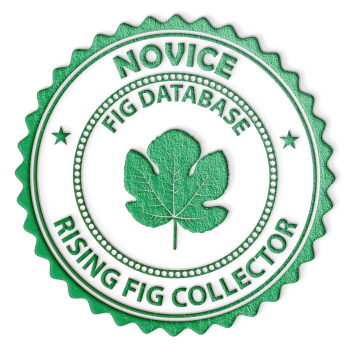- Joined
- Aug 30, 2021
- Messages
- 531
It's possible this story is too dark to use for marketing. I kind of want peer review for this one. Please chime in.
A Dark Tale of the Golden Fig
This is a story of how California figs, the famed "higos," went from being a staple of peasants and the poor to a delicacy selling for $10 a pound at Whole Foods. Called "Black Mission" or "Franciscana", this fig invariably is named after the men who popularized it throughout Spain, California, and the rest of the world. Chief among those men would be San Junipero Serra y Ferrer, a reformist monk of the Franciscan Order who founded the first nine Spanish missions in California from San Diego to San Francisco. Serra, who was of Catalonian origin not unlike Monserrat Pons but generations earlier, set off for the Americas by way of Cadiz at the age of 35, writing a letter to his illiterate parents to be read to them by one of his contemporaries to console them at the possibility of never again seeing their only son.
Spanish King Carlos III had just prior to this expelled all Jesuits from his kingdom, territories and colonies. The Jesuits, who had been in charge of the thirteen Baja, California missions prior to this, were replaced by, in effect, a military junta. Carlos III had decreed that the Franciscan Friars were to overtake day-to-day operations of the missions, and Serra set off from Spain to do just that. When he first set foot in America, he was a long way away from his destination of Mexico City, but he refused any form of transportation other than his own two feet. He believed Friars "must not ride on horseback unless compelled by manifest necessity or infirmity," and was of an order that mostly walked barefoot or, at best, wore sandals for long journeys. During the trek to Mexico City, Serra's left foot swelled up, and a burning itch tormented him. Arriving at a farm at day's end, he could hardly stand. He attributed the swelling to a mosquito bite. His discomfort caused him to stay over at the farm another night, during which he scratched his foot and leg to excess, desperately trying to relieve the itch. The next morning his leg was raw and bleeding. This wound plagued Serra for the rest of his life. When he finally hobbled into Mexico City, he was aghast to find the city occupied by military personnel, being run more as a fortress than a city. The city continued in this manner for some time, until a Royal decree officially handed control over to the Franciscans.
Serra's leg wasn't his only point of eccentricity. Self-abuse was kind of his thing. He was a fan of one of his Franciscan predecessors, Francisco Solano, who made the practice of self-flagellation popular. Serra thusly made a habit of punishing himself physically to purify his spirit. He wore a sackcloth spiked with bristles, or a coat interwoven with broken pieces of wire, under his gray friar's garments. In his austere cell, Serra kept a chain of sharp pointed iron links hanging on the wall beside his bed so that, if he had impure thoughts while sleeping or laying in bed awake at night, he could punish himself accordingly. His nightly self-flagellations at the college of San Fernando caught the ears of some of his fellow friars. In his letters to his Franciscan companions, Serra often referred to himself as a "sinner" and a "most unworthy priest." In one of his sermons in Mexico City, while exhorting his listeners to repent their sins, Serra took out this infamous chain, bared his shoulders and started whipping himself. Many parishioners, roused by the spectacle, began sobbing. Finally, a man climbed to the pulpit, took the chain from Serra's hand and began whipping himself, declaring: "I am the sinner who is ungrateful to God who ought to do penance for my many sins, and not the padre [Father Serra], who is a saint." The man kept whipping himself until he collapsed. After receiving the last sacraments, he later died from the ordeal. During other sermons on the theme of repentance, Serra would hoist a large stone in one hand and, while clutching a crucifix in the other, smash the stone against his chest. Many of his listeners feared that he would strike himself dead. Later, Serra suffered chest pains and shortness of breath; Palóu suggests that Serra's self-inflicted bruises were the cause. While preaching of hell and damnation, Serra would sear his flesh with a four-pronged candle flame—emulating a famed Franciscan preacher, John of Capistrano. Palóu described this as "quite violent, painful, and dangerous towards wounding his chest."
It is important to note the lifestyle espoused by these friars -- pain, punishment, austerity, poverty -- which they lived out fully in Serra's day. One might be tempted to wonder how the decadent, delicious Black Mission fig got tied up with these zealots... and one would not be faulted for such a question. The first mission founded by Serra was on May 14, 1769, entitled Misión San Fernando Rey de España de Velicatá, which was a grand name for a mud hut that was founded "with all the neatness of holy poverty." In this vain, the friars grew much of their own food, and no other variety of fig aside from the Mission fig, whose color when ripe is black. Figs were considered a food of the impoverished at this time, up until the gold rush saw Californian fruit being sold at exorbitant pirces to the hungry forty-niners flooding into the state. Lacking native Americans to convert locally, as many had been wiped out by epidemics throughout the arid Baja peninsuila, Serra feared the mission might fail before it had truly begun, but a few days later a friar brought a few natives before Serra who joyously rushed out to welcome all twelve of his native visitors with fresh figs--fitting for they were more naked than Adam, who at least had his fig leaf. He would later subject the natives to abuse that he had never dreamed of in his most self-abased fantasies, cementing the dark legacy of the "Black Mission" -- and this fig.
From a fruit whose flesh was considered its own form of punishment, like self-flagellation for a monk's nocturnal mental meanderings, to one of the most sought-after, highly-regarded fruits on the planet, figs have a story all of their own. The first fruit man ever cultivated to the last fruit I want to eat before my death, figs have been with the human race for a very long time. In California, it took hundreds of thousands of hungry, poor prospectors (along with some treacherous Turks, but that's a story for another time) to raise the illustrious fig to the height she enjoys today, and so rightly deserves.
Fig Flavor and Characteristics
Typically classified as a sugar fig, Black Mission does have hints of berry if one is prone to look for them. This is the quintessential fig that most people think of when they think of a dried fig. It is sweet, with figgy notes in between the sugar and twinges of berry. Great for fresh eating, but most often preserved by drying for consumption throughout the year.
The Black Mission was a great choice for the arid Baja peninsuila: kind of cold sensitive, it will produce a lot less fruit if hit by major frost the year prior. Zone 9 is recommended, but can survive down to Zone 7 outside. W. S. Anderson reported in 1924 that in south Mississippi, “the Black Mission was injured more than any other variety by the cold, and produced very few fruits. On the other hand, the fruit was of the highest quality, “standing up better when left on the tree during the rainy season than any other variety in the test.” On account of the productive capacity of the trees, resistance of the fruit to spoilage, and excellent quality both fresh and dried, the Franciscana (Black Mission) has long enjoyed an excellent reputation. The main objection to it commercially is the black skin color, which practically prohibits use of the dried fruit in fig paste.
Black Mission fig trees almost always come with some form of mosaic virus/FMV. It is considered normal on this type of tree.
A Dark Tale of the Golden Fig
This is a story of how California figs, the famed "higos," went from being a staple of peasants and the poor to a delicacy selling for $10 a pound at Whole Foods. Called "Black Mission" or "Franciscana", this fig invariably is named after the men who popularized it throughout Spain, California, and the rest of the world. Chief among those men would be San Junipero Serra y Ferrer, a reformist monk of the Franciscan Order who founded the first nine Spanish missions in California from San Diego to San Francisco. Serra, who was of Catalonian origin not unlike Monserrat Pons but generations earlier, set off for the Americas by way of Cadiz at the age of 35, writing a letter to his illiterate parents to be read to them by one of his contemporaries to console them at the possibility of never again seeing their only son.
Spanish King Carlos III had just prior to this expelled all Jesuits from his kingdom, territories and colonies. The Jesuits, who had been in charge of the thirteen Baja, California missions prior to this, were replaced by, in effect, a military junta. Carlos III had decreed that the Franciscan Friars were to overtake day-to-day operations of the missions, and Serra set off from Spain to do just that. When he first set foot in America, he was a long way away from his destination of Mexico City, but he refused any form of transportation other than his own two feet. He believed Friars "must not ride on horseback unless compelled by manifest necessity or infirmity," and was of an order that mostly walked barefoot or, at best, wore sandals for long journeys. During the trek to Mexico City, Serra's left foot swelled up, and a burning itch tormented him. Arriving at a farm at day's end, he could hardly stand. He attributed the swelling to a mosquito bite. His discomfort caused him to stay over at the farm another night, during which he scratched his foot and leg to excess, desperately trying to relieve the itch. The next morning his leg was raw and bleeding. This wound plagued Serra for the rest of his life. When he finally hobbled into Mexico City, he was aghast to find the city occupied by military personnel, being run more as a fortress than a city. The city continued in this manner for some time, until a Royal decree officially handed control over to the Franciscans.
Serra's leg wasn't his only point of eccentricity. Self-abuse was kind of his thing. He was a fan of one of his Franciscan predecessors, Francisco Solano, who made the practice of self-flagellation popular. Serra thusly made a habit of punishing himself physically to purify his spirit. He wore a sackcloth spiked with bristles, or a coat interwoven with broken pieces of wire, under his gray friar's garments. In his austere cell, Serra kept a chain of sharp pointed iron links hanging on the wall beside his bed so that, if he had impure thoughts while sleeping or laying in bed awake at night, he could punish himself accordingly. His nightly self-flagellations at the college of San Fernando caught the ears of some of his fellow friars. In his letters to his Franciscan companions, Serra often referred to himself as a "sinner" and a "most unworthy priest." In one of his sermons in Mexico City, while exhorting his listeners to repent their sins, Serra took out this infamous chain, bared his shoulders and started whipping himself. Many parishioners, roused by the spectacle, began sobbing. Finally, a man climbed to the pulpit, took the chain from Serra's hand and began whipping himself, declaring: "I am the sinner who is ungrateful to God who ought to do penance for my many sins, and not the padre [Father Serra], who is a saint." The man kept whipping himself until he collapsed. After receiving the last sacraments, he later died from the ordeal. During other sermons on the theme of repentance, Serra would hoist a large stone in one hand and, while clutching a crucifix in the other, smash the stone against his chest. Many of his listeners feared that he would strike himself dead. Later, Serra suffered chest pains and shortness of breath; Palóu suggests that Serra's self-inflicted bruises were the cause. While preaching of hell and damnation, Serra would sear his flesh with a four-pronged candle flame—emulating a famed Franciscan preacher, John of Capistrano. Palóu described this as "quite violent, painful, and dangerous towards wounding his chest."
It is important to note the lifestyle espoused by these friars -- pain, punishment, austerity, poverty -- which they lived out fully in Serra's day. One might be tempted to wonder how the decadent, delicious Black Mission fig got tied up with these zealots... and one would not be faulted for such a question. The first mission founded by Serra was on May 14, 1769, entitled Misión San Fernando Rey de España de Velicatá, which was a grand name for a mud hut that was founded "with all the neatness of holy poverty." In this vain, the friars grew much of their own food, and no other variety of fig aside from the Mission fig, whose color when ripe is black. Figs were considered a food of the impoverished at this time, up until the gold rush saw Californian fruit being sold at exorbitant pirces to the hungry forty-niners flooding into the state. Lacking native Americans to convert locally, as many had been wiped out by epidemics throughout the arid Baja peninsuila, Serra feared the mission might fail before it had truly begun, but a few days later a friar brought a few natives before Serra who joyously rushed out to welcome all twelve of his native visitors with fresh figs--fitting for they were more naked than Adam, who at least had his fig leaf. He would later subject the natives to abuse that he had never dreamed of in his most self-abased fantasies, cementing the dark legacy of the "Black Mission" -- and this fig.
From a fruit whose flesh was considered its own form of punishment, like self-flagellation for a monk's nocturnal mental meanderings, to one of the most sought-after, highly-regarded fruits on the planet, figs have a story all of their own. The first fruit man ever cultivated to the last fruit I want to eat before my death, figs have been with the human race for a very long time. In California, it took hundreds of thousands of hungry, poor prospectors (along with some treacherous Turks, but that's a story for another time) to raise the illustrious fig to the height she enjoys today, and so rightly deserves.
Fig Flavor and Characteristics
Typically classified as a sugar fig, Black Mission does have hints of berry if one is prone to look for them. This is the quintessential fig that most people think of when they think of a dried fig. It is sweet, with figgy notes in between the sugar and twinges of berry. Great for fresh eating, but most often preserved by drying for consumption throughout the year.
The Black Mission was a great choice for the arid Baja peninsuila: kind of cold sensitive, it will produce a lot less fruit if hit by major frost the year prior. Zone 9 is recommended, but can survive down to Zone 7 outside. W. S. Anderson reported in 1924 that in south Mississippi, “the Black Mission was injured more than any other variety by the cold, and produced very few fruits. On the other hand, the fruit was of the highest quality, “standing up better when left on the tree during the rainy season than any other variety in the test.” On account of the productive capacity of the trees, resistance of the fruit to spoilage, and excellent quality both fresh and dried, the Franciscana (Black Mission) has long enjoyed an excellent reputation. The main objection to it commercially is the black skin color, which practically prohibits use of the dried fruit in fig paste.
Black Mission fig trees almost always come with some form of mosaic virus/FMV. It is considered normal on this type of tree.
Last edited:


